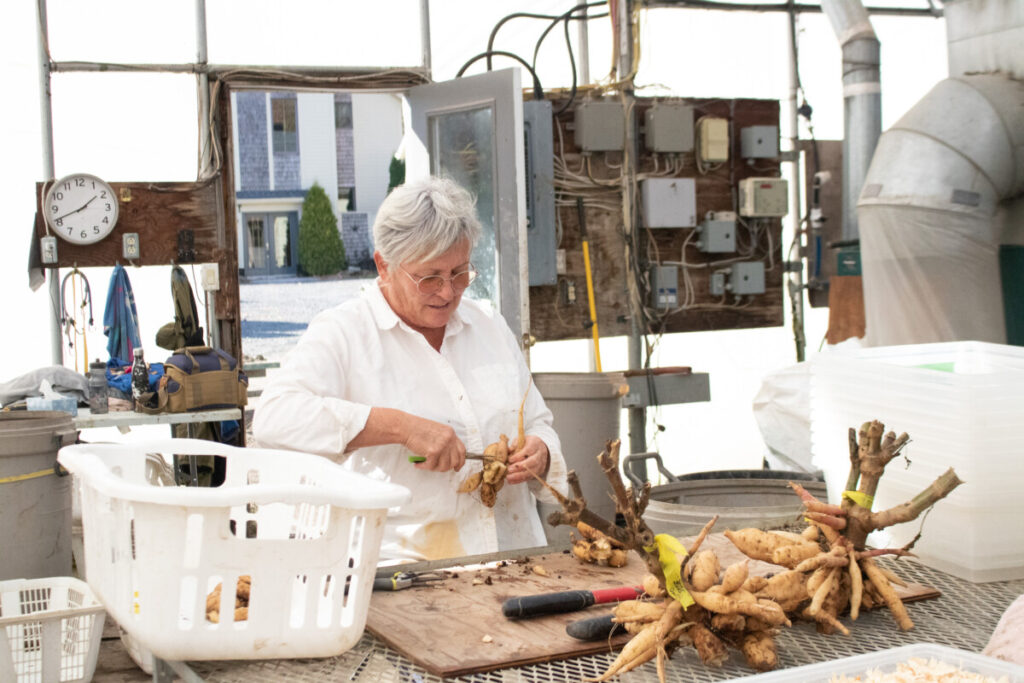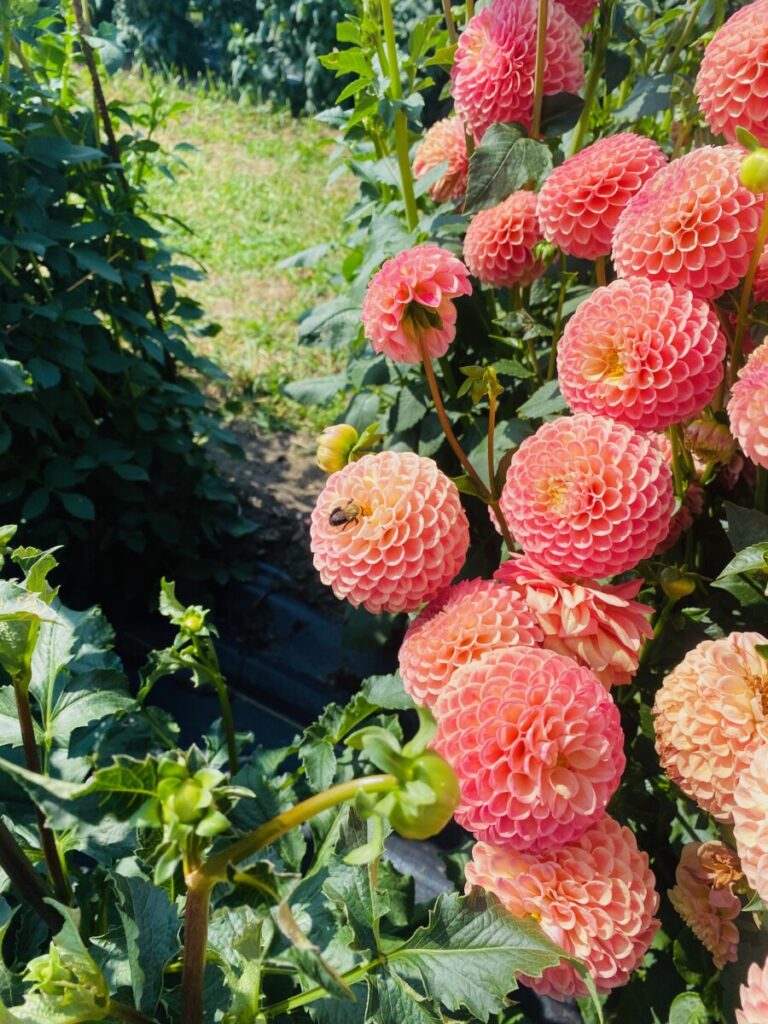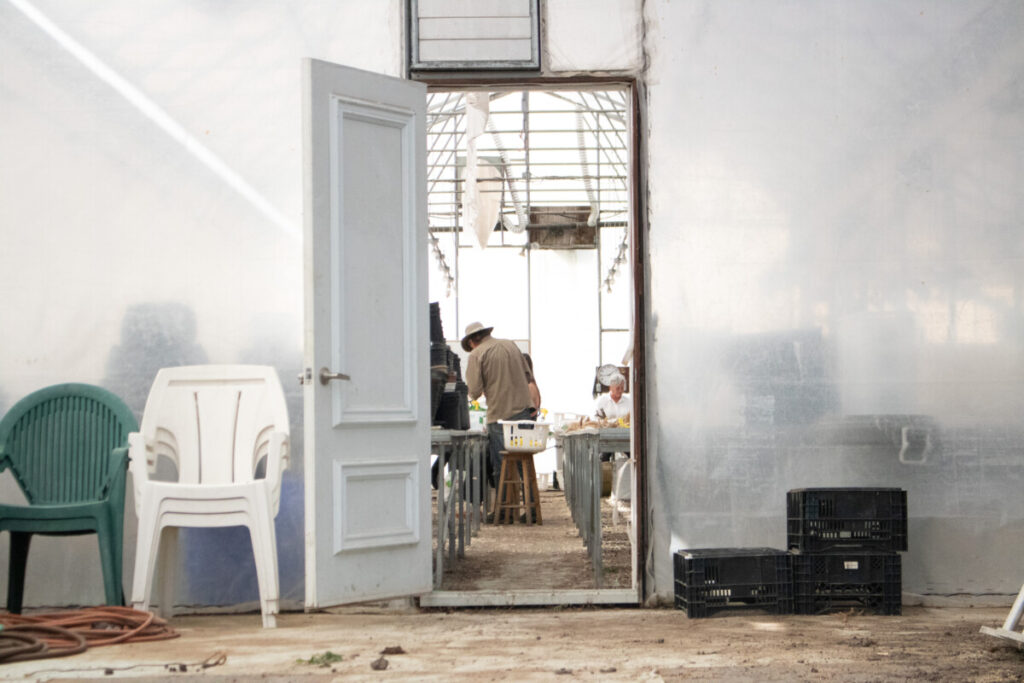Learn about the secret to growing healthy cut flowers
During the month of August, Au Beau Pré is a sight to see. Over 300 varieties of Dahlias are in full bloom. They come in every shape, size, colour and texture that one could only dream about. This flower field gives visitors the option to come and cut their own flowers to take home. Walking through the rows of the field, it could be hard deciding which Dahlias to add to your bouquet.
The methods of production for flowers have always involved the use of pesticides, which in turn harm the people that produce them. 2,000 Canadian farms are trying to find better solutions to produce them organically, without pesticides. The Slow Flower Movement (SFM) is one of those remedies in terms of how farms treat their soil.
According to Flowers Canada Growers, there are over 1,600 flower producers in Canada. Flower farms cover over 75 million square feet of land combined. Among these flower producers is Sarah Beaupré Quenneville, a young entrepreneur heading her family’s beloved flower farm. Au Beau Pré flower farm sits in Saint Anicet, also known as “Quebec Florida” for its higher humid temperatures than the rest of the province. Au Beau Pré implements the SFM.
The secret to success for this flower farm is in their soil. “For the soil, we put compost every year or every two years depending on the crop,” Quenneville explained.
According to Architectural Digest, the Slow Flowers Movement refers to the methodical preparation of soil before a seed is even planted. Farms across Quebec are slowly adopting this movement, like The Enfants Sauvages, among others.
Before Quenneville took on her family’s farm, her parents Roger and Lilianne were in charge and adopted the SFM. They started the Au Beau Pré farm back in 2007.

“This is my parent’s project. They were selling Dahlia flower bulbs for years,” Quenneville said. “Before, they specialized in wheat production and made grain based products.”
Growing up, Quenneville had no interest in the agricultural sector and she didn’t want to be as involved in the farm.
“I saw my dad working hours and hours on end, with no days off,” Quenneville recalled.
With a family of her own, Quenneville explained that she didn’t want her children to experience the same memories she had as a child.
Quenneville studied communications during her undergrad and worked in media for a couple of years.Though she would sometimes help, Quenneville never envisioned the farm as a potential career opportunity.
“With each year that passed, my parents kept on asking me, ‘Are you sure you don’t want to do anything with the land?’” Quenneville recalled. “I proceeded to telling them, ‘No it’s not my thing, it’s maybe yours but not mine.’”
However, one day her mother told her about the endless possibilities of utilizing cut flowers. A cut flower is a bud or a flower that is cut from its bearing plant. Customers usually opt to buy cut flowers solely for decorative purposes, such as a bouquet.
According to Slow Living LDN, the SFM aims to not only have a better understanding of the soil before a flower is planted but also a more mindful consumption of how they’re cut.

A TURNING POINT –
“We discovered I had a certain talent with selling flowers. I always helped my parents during the summer. My parents always said, ‘You’re good with the flowers,’” Quenneville recalled. During the times where she couldn’t be as involved in the field, she would help her parents with the website and the online selling of the products. “My parents are not really good with selling their stuff online, they’re good producers but not very good sellers.”
For newer flower producers like Quenneville, ressources and helpful guides are always available. At Flower Canada Growers in Toronto, Pest Control specialist Cary Gates explains that the SFM may work for some flower farms but not all.
“I don’t know if I see a lot of farms embracing that kind of approach,” Gates explained. “I am supportive of it, I just don’t know logistically if it is super functional, I see it for smaller acreages as being very achievable.”
Smaller farms like Au Beau Pré implement the utmost care into the soil before the Dahlia flower bulbs are even planted. “I really like the focus that farmers put into soil health,” Gates said. The care that is put into the soil equates to better quality flowers.
Quality control is also very important to the family. Roger and Lilianne make sure that the Dahlia flower bulbs don’t have any illnesses; however, sometimes unpredictable things can happen.
“One year we lost 75 per cent of our bulbs, we didn’t know exactly what happened in the fridge but they all rotted. I tell our customers I am not selling ‘Post-Its,’ we are selling living things and sometimes things like that can happen,” Quenneville recalled.
With Quenneville taking the reins on her parent’s farm in 2019 came its problems. “The first challenge I really faced was that I didn’t know how to produce flowers,” Quenneville said.
As the years progressed, Quenneville took more of an interest in the cut flowers business and became a project that she eventually took on. Quenneville explained that at Au Beau Pré, they sell flowers when they are cut from the stem itself. When guests come to visit the field in the month of August, they pay per flower stem.
With the help of various workshops through an American cut flower guru called Floret Flowers, Quenneville learnt the ins and outs of how to produce cut flowers.
Learning how to produce cut flowers with Floret Flowers also taught Quenneville another important lesson of the SFM: how to produce flowers at the most optimal time.
Au Beau Pré tries to keep up with business year-round. The winter season preparations start in October, right at the first freeze.
“We do some chores with an old tractor, but most of the time we work the soil manually. This way we don’t mess with the soil structure too much and we can start working in the field faster in the spring,” Quenneville said.
LOOKING AT OTHER PROVINCES –
One of the ways floral producers band together is through flower associations to help each other learn about sustainable ways of production.The Flowers Canada Growers Association (FCGA) has members all over Canada, including Bailey Dueker, owner of The Boondock Flower Farm in Saskatoon.
Dueker got into the business by accident, she recounted. “This will be my fourth season growing in 2023. In the spring of 2019 I was sick of Facebook so I joined Instagram. I wanted to see flowers in my recommended page, so I started to follow all these flower farmers,” Dueker said.
Seeing the flower farmer feeds inspired her to get into the field and she did not return to her regular job following her maternity leave. During the fall of 2019, Dueker did what she called a “soft-launch.” She acquired all the sunflowers and zinnias from her garden. Over the winter she spent her time buying seeds. “You really don’t know how much you don’t know until you get into it,” Dueker explained.
Across Canada, flower farms are underestimated in terms of the leg work that it takes to produce. According to a Chatelaine article on the subject flowers have brought in an estimated $158 million in profit in 2021.
FCGA represents floral producers all over Canada. Their members across Canada include greenhouse growers, distributors and importers/exporters all dealing with cut flowers, potted plants, bedding plants, cut greens and specialty suppliers and services to the industry.
Dueker explained that the main goal of being a part of the FCGA is providing more knowledge about the floral industry to others in the country. When you have a question that needs to be answered, there’s always someone there to help. “Connecting and marketing with other growers is the main idea of the association,” Dueker said.
Dueker also explained that there is a Facebook group for the association where members can connect with a community of flower growers.
According to Deuker, the future of cut flowers lies with the grassroots movement, which has a similar idea to the Slow Flowers movement. “I see a lot of people getting out of it in a couple of years because they come to realize that you have to do quite a bit of an investment to make it a living,” Dueker explained. Dueker has seen within the industry that perhaps selling to florists is maybe the way to go.

Beau Pré Dalia Nardolillo/THE CONCORDIAN
FUTURE OF THE AU BEAU PRÉ FLOWER FIELD –
As the farm plans for the future, Quenneville explained that the future lies within the flowers themselves. “I really want to try to make products from the flowers themselves. We worked a lot from the dried flowers and we liked working with them.”
Working with the dried flowers over the past summer was a trial and error process. We weren’t quite there in terms of the final product with the dried flower bouquets,” Quenneville recounted.
Before perfecting any sort of dried flower she wants to master the production of them.
“We try different things, of course our Dahlia bulbs are our most popular product. We try to keep the cut flowers during the summer. This year was the first time that we tried the tulips but I don’t want to get into making my own seeds because that’s its own production.”
Quenneville believes that the future of her business lies with online sales through her website. While visitors travel to Saint Anicet during the summer to get the cut flowers from the farm, Quenneville wants to have flower-based products that she can sell year-round to customers.
The cut flower industry is always changing and florists are always trying to adapt, whether that is in the different dried flower products or brushing up on their knowledge of how to better treat their soil. Gates explained that the future of the cut flowers isn’t going anywhere for now. “I see the cut flower industry as pretty stable, I don’t know if I see it expanding exponentially like other ornamental commodities grow.”




